|
Author
|
Topic: Name that astronaut (spacewalk?) tool
|
Robert Pearlman
Editor Posts: 42981
From: Houston, TX
Registered: Nov 1999
|
 posted 08-01-2008 01:29 PM
posted 08-01-2008 01:29 PM
   
Okay astronaut equipment fans, what is this?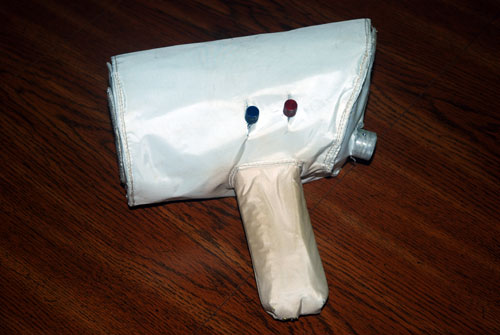
It measures 8" across and approximately 9" tall (4.5" handle). The entire metal body is covered with a thermal micro-meteroid (TMG) layer. 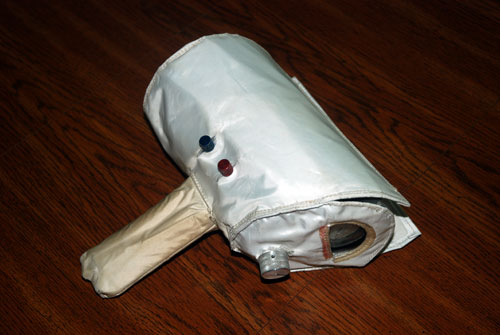 There is a silver knob at one end and two smaller knobs, red and blue, on the side. 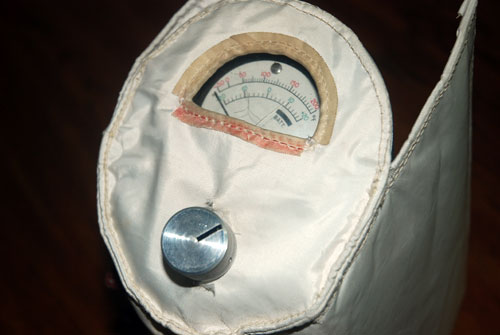 The gauge appears to measure temperature. 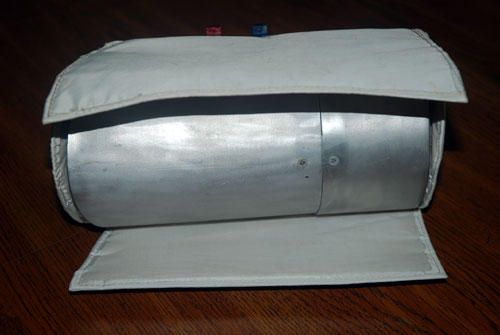 Under the TMG layer, is an aluminum body and handle. There are no markings of any type. The handle does not have a trigger. Unscrewing and opening the device reveals a small circuit board, wiring and a badly corroded battery, as well as other components. 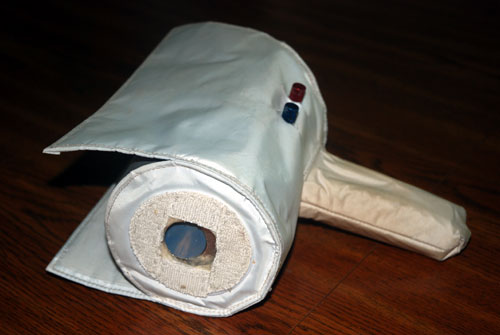 The circular opening on the opposite side of the gauge is covered in clear plastic and appears to be for a sensor. The corresponding opening on the TMG layer is surrounded in velcro. The TMG layer suggests EVA use but the knobs are not what I would expect of a glove-friendly design. Does anyone recognize it and if so, when and why was it used? |
poofacio
Member Posts: 268
From: United Kingdom
Registered: Oct 2006
|
 posted 08-03-2008 03:35 AM
posted 08-03-2008 03:35 AM
   
If you lived in the UK Robert you would recognise it as being created at vast expense by a tiny minded British policeman with a view to catching astronauts breaking the statutory speed limit in a lunar rover! |
LCDR Scott Schneeweis
New Member Posts:
From:
Registered:
|
 posted 08-04-2008 04:14 AM
posted 08-04-2008 04:14 AM
   
Rob... just happened across this post. Based on details it looks to me like a mock-up of a Pyrometer. Can you provide a better image of the gauge as well as the forward sensor?Scott ------------------
Scott Schneeweis
http://www.SPACEAHOLIC.com/ |
Robert Pearlman
Editor Posts: 42981
From: Houston, TX
Registered: Nov 1999
|
 posted 08-04-2008 09:57 AM
posted 08-04-2008 09:57 AM
   
quote:
Originally posted by LCDR Scott Schneeweis:
Can you provide a better image of the gauge as well as the forward sensor?
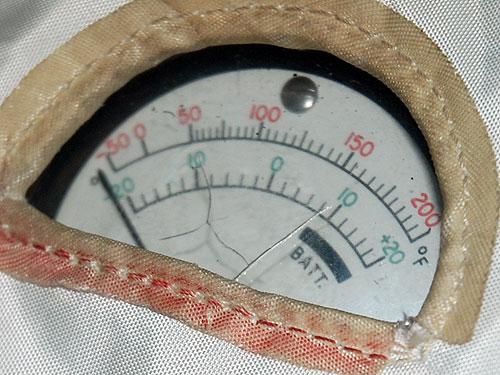
Photographing the sensor face-on is a no go -- the translucent covering prevents seeing any detail. Here's a look 'under the hood': 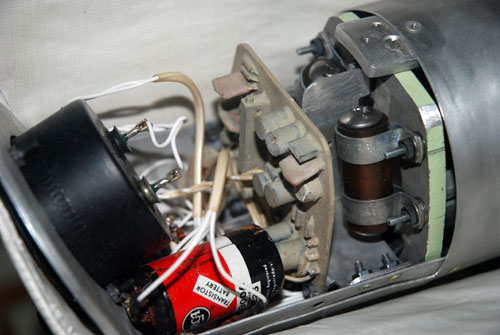
|
LCDR Scott Schneeweis
New Member Posts:
From:
Registered:
|
 posted 08-04-2008 10:44 AM
posted 08-04-2008 10:44 AM
   
Staying the course... its an (old as dirt) mock-up analog pyrometer. |
Robert Pearlman
Editor Posts: 42981
From: Houston, TX
Registered: Nov 1999
|
 posted 08-04-2008 10:50 AM
posted 08-04-2008 10:50 AM
   
quote:
Originally posted by LCDR Scott Schneeweis:
Staying the course... its an (old as dirt) mock-up analog pyrometer.
Any guesses on which program this was built for? Skylab? Early shuttle? And what it might have evolved into (as in is there a corresponding flight unit)? |
LCDR Scott Schneeweis
New Member Posts:
From:
Registered:
|
 posted 08-04-2008 11:01 AM
posted 08-04-2008 11:01 AM
   
No discernible clues on program affiliation..maybe somebody familiar with TMG fabrication and the electronics components can cross link this to a time-period it would have been produced (or at least determine if it is post Skylab) |
Mr Meek
Member Posts: 353
From: Chattanooga, TN
Registered: Dec 2007
|
 posted 08-04-2008 11:16 AM
posted 08-04-2008 11:16 AM
  
Pull the source-date codes off of the potentiometer, capacitors, or any other major component. It would at least give you an idea of when the part was made, and possibly the entire assembly.The thing can only be as old as its newest component, unless its a component that was clearly a replacement. Here's a guide for using the source-date codes for dating vintage musical equipment. However, it may work for this piece. |
spacekid2
Member Posts: 199
From: San Diego, CA, USA
Registered: Jul 2004
|
 posted 08-04-2008 04:53 PM
posted 08-04-2008 04:53 PM
   
Robert, Throwing my two cents in. The RCA battery itself is as Scott said "as old as dirt". Dating the battery could yield clues to the time it was assembled. To me the battery looks to be mid to late 70's. Paul |
LCDR Scott Schneeweis
New Member Posts:
From:
Registered:
|
 posted 08-04-2008 05:58 PM
posted 08-04-2008 05:58 PM
   
Is it possible what may be throwing us off is the perception that the external covering is in fact TMG (like) and thus designated for EVA application? Perhaps this device was never intended for space at all but instead designed for terrestrial use. Other then the appearance Rob, is there any other background information you hold which would support a role for this item aloft?
|
Robert Pearlman
Editor Posts: 42981
From: Houston, TX
Registered: Nov 1999
|
 posted 08-04-2008 06:05 PM
posted 08-04-2008 06:05 PM
   
quote:
Originally posted by LCDR Scott Schneeweis:
Other then the appearance Rob, is there any other background information you hold which would support a role for this item aloft?
I know for a fact its that origin is NASA (in an astronaut-related way) and can attest that the TMG layer is identical in construction, appearance and even smell to other EVA equipment I've seen or handled.
|
Robert Pearlman
Editor Posts: 42981
From: Houston, TX
Registered: Nov 1999
|
 posted 08-04-2008 06:58 PM
posted 08-04-2008 06:58 PM
   
quote:
Originally posted by spacekid2:
Dating the battery could yield clues to the time it was assembled. To me the battery looks to be mid to late 70's.
Well, according to this obituary, the modern rectangular 9-volt battery (aka PP3) was designed by Dr. Alexander "Lex" Gilmour in the "early 1970s". The first 9-volt battery, according to Energizer, was invented in 1956 (although their website depicts the modern PP3, the round-style preceded it). Thus, in theory, this device was designed sometime between 1956 and the 1970s. Certainly, any device made by the early 80s for shuttle would have used the rectangular PP3. Interestingly, Dr. Gilmour's obituary also mentions he designed "electrical power equipment for Apollo spacecraft modules," though that's only a coincidence. |
Spacepsycho
Member Posts: 818
From: Huntington Beach, Calif.
Registered: Aug 2004
|
 posted 08-04-2008 11:28 PM
posted 08-04-2008 11:28 PM
   
Robert,If this was some type of heat detector that was designed to be used during an EVA, it should have some type of attachment loop, so it didn't float away. Looking at the photos, there doesn't seem to be any type of attachment loop, so it might have been used on orbit from inside the crew cabin. |
Robert Pearlman
Editor Posts: 42981
From: Houston, TX
Registered: Nov 1999
|
 posted 08-04-2008 11:31 PM
posted 08-04-2008 11:31 PM
   
This is most certainly a training unit and not flight hardware, which could explain the lack of a tether point. That said, there'd be little point to a TMG layer unless it was designed for use outside the spacecraft. |
Mr Meek
Member Posts: 353
From: Chattanooga, TN
Registered: Dec 2007
|
 posted 08-05-2008 12:14 AM
posted 08-05-2008 12:14 AM
  
Robert, if you've got the time, some detailed pics of the back of the potentiometer/switch, and the components around and on the PC board could be extremely helpful in dating this piece. I don't think dating it by the battery alone will be particularly informative, due to the mockup nature of the piece. I know disassembly is out of the question, but are you opposed to hitting it with some canned air to clean it up a bit? Hey, you've got nothing better to do while the storm blows through, right?  |
spacekid2
Member Posts: 199
From: San Diego, CA, USA
Registered: Jul 2004
|
 posted 08-05-2008 12:19 AM
posted 08-05-2008 12:19 AM
   
Robert,What throws me off is that the temp gauge allows for higher temps but also below zero temps? And the velcro? I have a great idea. Here is the web page for the History Detectives. I would call them and they could do a TV segment on this unique piece. They would go all out to find the origin. They even sometimes find other treasures that they pass along to the owner. It would certainly help to highlight unique space collectibles.  You may have to wait a little longer to find out what this piece is and was but it would be so much fun watching the show. Come on Robert, give it a shot. Paul |
Robert Pearlman
Editor Posts: 42981
From: Houston, TX
Registered: Nov 1999
|
 posted 08-05-2008 12:22 AM
posted 08-05-2008 12:22 AM
   
quote:
Originally posted by Mr Meek:
I know disassembly is out of the question, but are you opposed to hitting it with some canned air to clean it up a bit? Hey, you've got nothing better to do while the storm blows through, right?
Sure thing, I'll just hold it out the window tomorrow morning...All jokes aside, here's the odd thing: what looks like dust isn't. I can see the hint of color and writing underneath on the circuit board's components, but using my fingernail, it requires a great deal of effort to scratch away even a little bit of the gray caked-on material. |
Robert Pearlman
Editor Posts: 42981
From: Houston, TX
Registered: Nov 1999
|
 posted 08-05-2008 12:25 AM
posted 08-05-2008 12:25 AM
   
quote:
Originally posted by spacekid2:
I have a great idea. Here is the web page for the History Detectives.
Coincidentally enough, the History Detectives contacted collectSPACE a few months ago asking if we had any space artifacts that might be suitable for their show. At the time we didn't; I'll write their producer now. |
spacekid2
Member Posts: 199
From: San Diego, CA, USA
Registered: Jul 2004
|
 posted 08-05-2008 01:23 AM
posted 08-05-2008 01:23 AM
   
Robert,Does that mean that I will get a cameo?  I can't wait to hear what happens. Paul |
robsouth
Member Posts: 769
From: West Midlands, UK
Registered: Jun 2005
|
 posted 08-05-2008 04:48 AM
posted 08-05-2008 04:48 AM
  
To me it looks too bulky/heavy/crude to be actual space hardware but I could be wrong. Take a look at those scews and bolts, they don't look very space age to me. My best bet is it was some kind of ground based measuring device, maybe used during temperature or vacuum chamber training. |
space1
Member Posts: 853
From: Danville, Ohio
Registered: Dec 2002
|
 posted 08-05-2008 05:58 AM
posted 08-05-2008 05:58 AM
   
Actually it's the screws and bolts that DO look aerospace to me, in particular the nuts on the screws. They are a locking type used in vibration environments. I have gotten those types of nuts along with flight type hardware in surplus lots. They were popular with Rockwell designers, so that implies Apollo/Shuttle era (a few decades!). Whatever its purpose, it may have been put together by a shop that had those types of nuts lying around.The circuit card appears to have some kind of sealant over it. But it is not the fireproof coating used on flight equipment after Apollo 1. So I agree with robsouth - we're probably talking ground use here. ------------------
John Fongheiser
President
Historic Space Systems, http://www.space1.com |
Mr Meek
Member Posts: 353
From: Chattanooga, TN
Registered: Dec 2007
|
 posted 08-05-2008 10:54 AM
posted 08-05-2008 10:54 AM
  
quote:
Originally posted by Robert Pearlman:
It requires a great deal of effort to scratch away even a little bit of the gray caked-on material.
Ah. Yep, that's a sealant to limit damage to board-mounted components from rough handling. Do you have a higher-res version of the inside shot? If so, would you email it to me? Thanks. |
Robert Pearlman
Editor Posts: 42981
From: Houston, TX
Registered: Nov 1999
|
 posted 08-05-2008 12:25 PM
posted 08-05-2008 12:25 PM
   
Here are some high resolution shots of the interior (rather than e-mail them, I'm posting them so others can see if they so desire). Click on the embedded images to enlarge (each file is about 1.5 mb).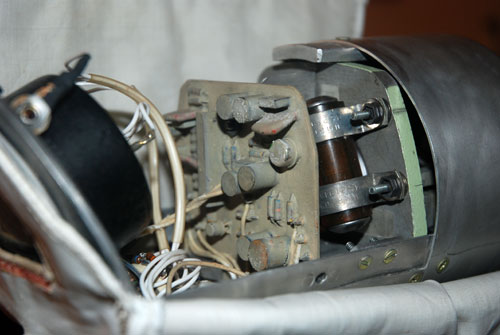
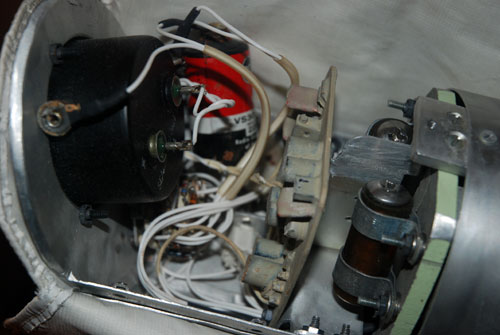
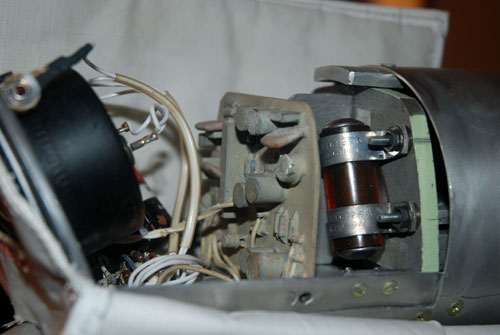
|
Mr Meek
Member Posts: 353
From: Chattanooga, TN
Registered: Dec 2007
|
 posted 08-06-2008 08:23 AM
posted 08-06-2008 08:23 AM
  
Hmm. Well, the clamps are a current (or recent) production item from Umpco. However, Umpco has been making clamps for the aerospace industry for more than 50 years. (Thanks, Google!)What's the number beginning with VS on the battery? It's a model number, not a source-date code. Does the battery say it's 9V? The usage of carbon comp resistors in a low voltage application suggest nothing later than mid 70's. Carbon comp resistors have a tendency to be noisy, and were replaced by metal film and wirewound resistors in more critical applications. Guitar amp snobs such as myself insist they sound better, but their electrical tolerances are a little broad by NASA standards. Can I see the back of the circuit board? It's probably covered in that sealant as well, but the "style", if you will, of etching can help date the piece. Shoot, can you just send me the thing?  Seriously, though, I think it's Skylab-era, or just after. If we could get the numbers off of some of the board-mounted components, though, we'd have more than my amp tech intuition to go on. |
spacekid2
Member Posts: 199
From: San Diego, CA, USA
Registered: Jul 2004
|
 posted 08-07-2008 07:01 PM
posted 08-07-2008 07:01 PM
   
Robert, I am at work and I think I have found what I believe to be the answer. Alright, not the full answer but close. I think that what you have is an early prototype of a Portable Emissometer. AZ Technologies developed a Space Portable SpectroReflectometer that was used on the MIR spacestation. This web page links to another one of their devices and it looks like a close match to your hardware. This is the description that they give: AZ Technology's unique line of highly accurate portable and laboratory portable instruments for measuring the optical properties of materials; specifically, solar absorption, emittance, reflectance, and transmittance are summarized below with links to more detailed information. AZ Technology also has the expertise and experience to custom develop related instruments. Anyway, I thought this comes close to what you have. Paul |























